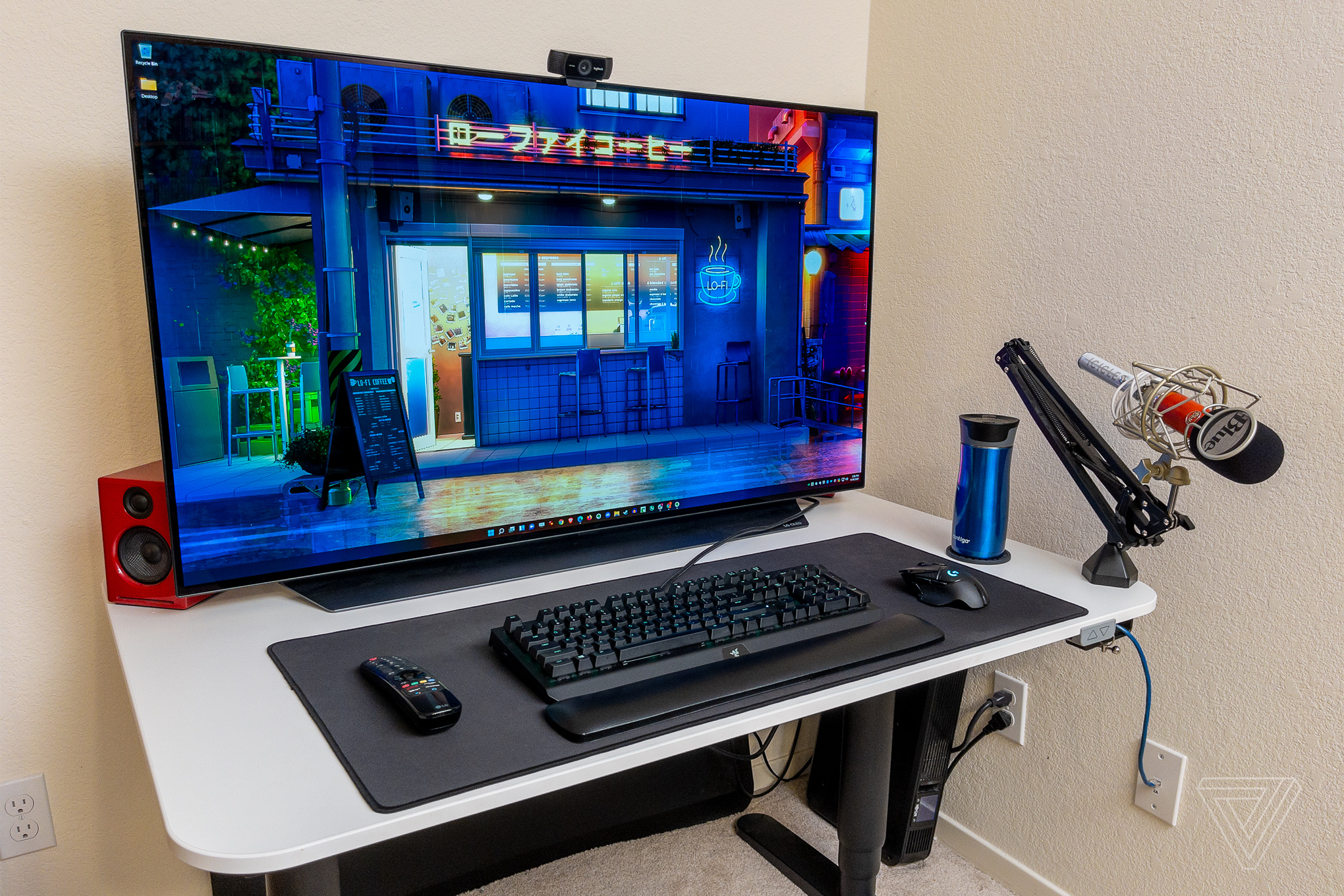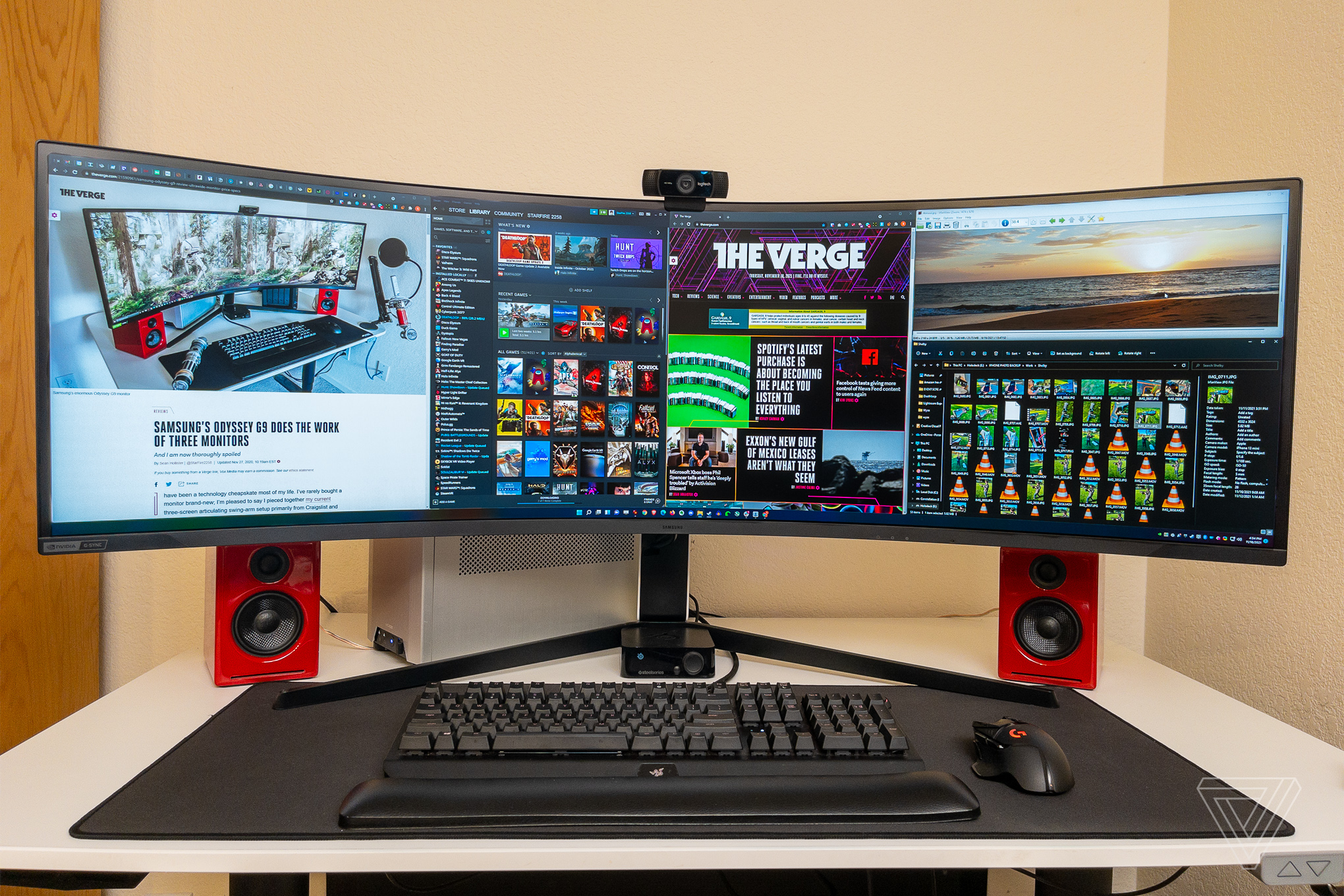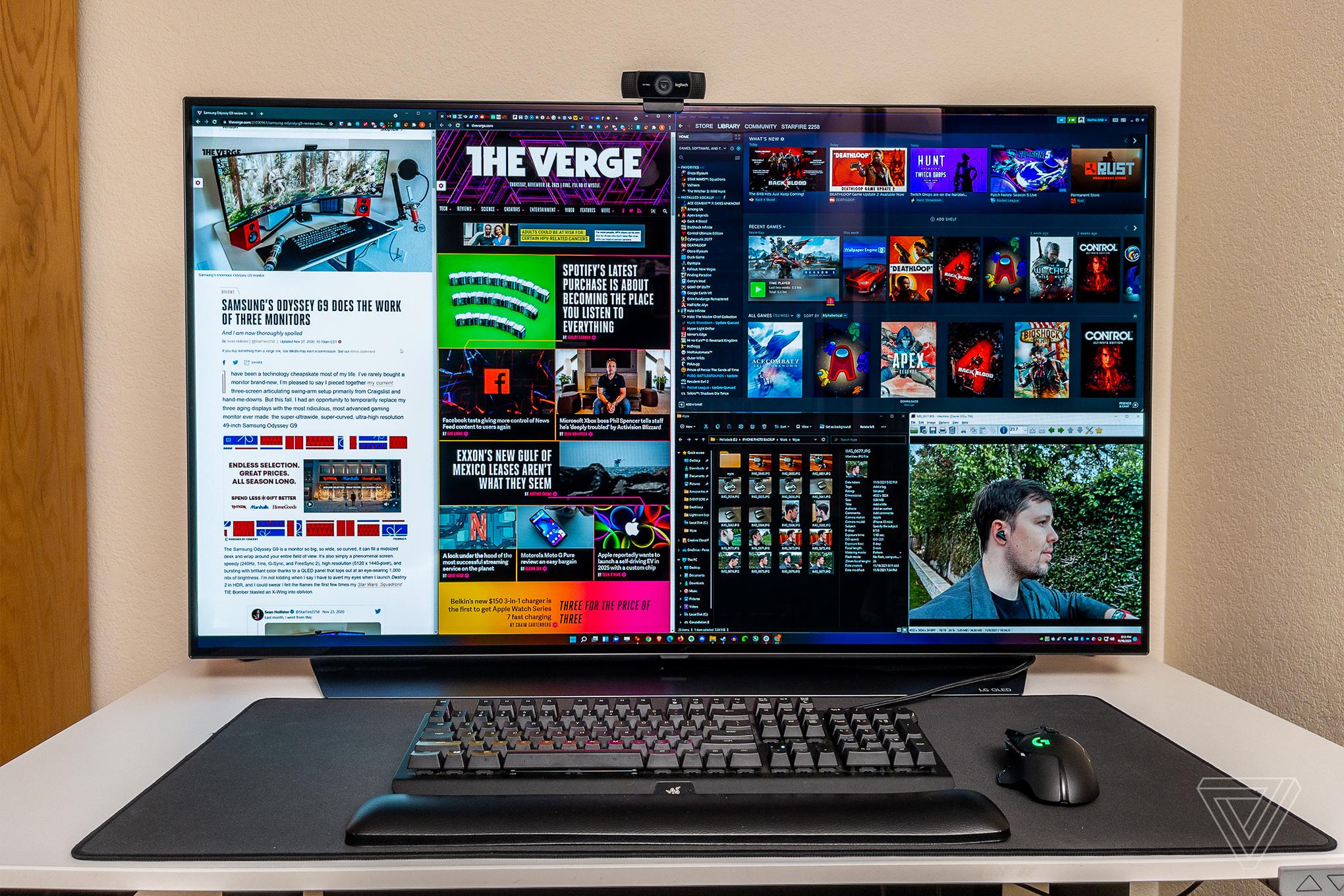/cdn.vox-cdn.com/uploads/chorus_image/image/70258107/neo_g9_vs_lg_c1_oled.0.jpg)
I hate leaving unfinished business, but that’s what I did on November 27th of last year. I ended my review of the most ridiculous, most advanced PC monitor ever made — the 49-inch Samsung Odyssey G9 — by wondering out loud whether a similarly sized OLED television might actually be better. That question has been burning in my skull for many, many months, but I’m happy to say I finally have an answer.
This September, I took delivery of both LG’s latest 48-inch C1 OLED television and Samsung’s upgraded 49-inch Odyssey Neo G9, with its Mini-LED backlit screen that attempts to rival OLED for deep blacks and adds explosive brightness. I’ve used them back to back ever since, swapping again and again between the latest and greatest gigantic gaming monitors and between work and play. I used them all day, every day, jotting down notes about every frustration and all the joy I experienced with these monster screens just a foot or two from my face.
It was awesome, and I’m not sure I’m ready to go back to the comparatively puny 27-inch screen I actually own. But the funny thing is, my answer is neither. Neither of these screens is my PC monitor endgame. And I wasn’t even sad to see one of them go home.
First, the basics. Why a monitor versus a TV? Well, for a staggering $2,499, the Samsung Odyssey Neo G9 is arguably the most feature-packed gaming monitor ever made — and yet LG’s $1,299 48-inch OLED TV meets or beats it in most ways that matter.
For instance, the Samsung has a tremendous 5120 x 1440-pixel resolution panel that stretches out across your entire field of view, practically letting you bathe in games or tasks. But the sheer size of LG’s 48-inch 3840 x 2160 panel also fills your view at what’s technically a higher resolution (8.3M pixels vs. 7.4M pixels). It’s just that the corners of LG’s screen are a bit farther away from your face because it’s not curved like Samsung. (I have more to say about that later.)
Both monitors have a similar footprint on a desk, too, at 45.3 inches wide for the Odyssey G9 and 42.2 inches wide for the 48-inch LG, but it feels like the LG provides so much more screen in exchange. We’ve long made fun of small 16:9 laptop screens for being too short for productivity, but LG’s 24-inch-tall slab of pixels is far, far past the point where that’s an issue. Every time I swapped out the Neo G9 for the LG C1 (or vice versa), I had to ask myself why I would pay twice as much for a screen with the top and bottom chopped off when both fit fine on my 47-inch Ikea Bekant desk.
And while the Samsung monitor does reach twice the refresh rate at 240Hz, compared to 120Hz for the LG, highly technical review sites like Rtings will tell you the LG is actually better when it comes to response time and blur (which is what we actually care about when we care about refresh rate). For variable refresh rate, both support Nvidia G-Sync, AMD FreeSync Premium or Premium Pro, and the latest HDMI 2.1 with VRR for Xbox Series X and (eventually) the PS5 as well.
Wondering if a TV might guzzle more electricity than a dedicated monitor? It’s a fair question, but you might be surprised. Playing through the same exact section of Deathloop with HDR, I averaged 68Wh per hour with the 48-inch LG, compared to 89Wh per hour with the Samsung Neo. When I added desktop apps, it was a bit closer: the LG consumed 85Wh per hour, while the Samsung drank 91Wh per hour on average. That’s with power saving settings turned off on the LG — and I’d recommend you do that right away because it’s really dim out of the box.
Despite all this, it’s not necessarily that simple to swap your traditional monitor for either of these gigantic panels. Let’s talk gaming, productivity, and lastly, we’ll spend a few words chatting about your desk.
:no_upscale()/cdn.vox-cdn.com/uploads/chorus_asset/file/23040338/shollister_211124_4893_0007.jpg)
Gaming
I’m not going to rehash my entire Samsung Odyssey G9 review, where I included 14 full-bleed images to show you what gaming is like on a 32:9 screen, but I’ll give you the TL;DR version here: super-ultrawide gaming is wonderful but weird. Playing on the Odyssey G9 and Neo G9 is incredibly immersive, but it’s also literally warped in a way I don’t always find pleasant because game developers never adopted multi-projection in their games. And in the year since that review, nothing’s changed.
I played a new bunch of Halo Infinite multiplayer, dove through all of Deathloop, and played through the entire Back 4 Blood campaign swapping between the Odyssey Neo G9 and the LG C1 48. While all three of these games have perfectly adequate 32:9 support, and Halo even marketed it as a feature, all of them have that stunted-and-zoomed look on the left and right sides of the screen.
:no_upscale()/cdn.vox-cdn.com/uploads/chorus_asset/file/22925723/HaloInfinite_2021_10_02_14_56_13_996.jpg)
:no_upscale()/cdn.vox-cdn.com/uploads/chorus_asset/file/23079879/Screenshot__40_.png)
I don’t always hate it. But I would never, ever choose to play them on the Odyssey Neo G9 instead of LG’s 48-inch gaming television, where every game automatically looks fantastic because they’re designed for 16:9 to begin with. It’s just as immersive, if not more so, given that you’ve got more screen and fewer distracting warped edges in view. And it doesn’t help Samsung that its monitor has some extremely strange results displaying HDR and 240Hz content, too.
Like I said, the LG set already punches harder than its Hz would suggest when it comes to busting blur, but the Samsung Neo G9 also appears to have weird problems with its 240Hz mode, most prominently that it will display visible horizontal lines across portions of the display, ones that are most visible on gradients, bright colors, or when the panel’s full-array local dimming gets particularly dark or bright all of a sudden. A big, splashy, story-critical explosion in Deathloop was ruined for me when horizontal lines cut through what would otherwise have been an extremely impressive burst of flame — the kind of thing that the Neo’s peak brightness of 2000 nits makes so bright you might swear you can feel the heat.
Here’s a video example of what the horizontal lines look like when the screen gets dim:
And I’m far from the only one who’s seen this issue — or the issues with HDR in general, where the Neo G9 shipped with HDR support that can charitably be described as “broken” and has only reached “partially acceptable” after months of firmware updates.
Originally, turning on HDR mode would wash out the colors of your entire Windows desktop, though that’s now fixed. But even after the latest firmware update (which you have to download on a PC, then apply directly to the monitor with a thumb drive after removing any USB peripherals from the monitor’s USB ports), some of the dark shadowy regions of Deathloop look green and Back 4 Blood looks like it’s being flooded by the headlights of a car. Tweaking luminance and color helped some, but the best result I could muster was still far shy of the fantastic results LG gave me without tweaking at all.
(Hardware Unboxed deserves serious credit for pushing Samsung on these problems, going through multiple review units and feeding Samsung data, and Techtesters recently testified they’d gone through three different review units as well.)
It’s wild because last year’s Odyssey G9 also suffered from some quality control issues around its 240Hz mode (which didn’t work with some graphics cards out of the gate) and poor local dimming, and we figured a Neo G9 (at twice the price!) would solve both. But while the new Mini-LED full array local dimming provides those fantastic deep blacks around, say, the borders of a movie you’re watching, we aren’t seeing that in games where we definitely should.
At 120Hz or 144Hz without HDR, the Odyssey Neo G9 was fairly satisfactory, not unlike the vanilla Odyssey G9 I tested last year. But that original G9 is also over $1,000 less expensive — and so is LG’s set.
Productivity
And yet, if you plan to get work done on your new gigantic screen, I can’t wholeheartedly recommend an LG TV, either.
People ask me two questions: “Aren’t you worried about burn-in?” “Don’t you get headaches sitting two feet away from the TV?”
The answer is that LG gives me my choice of headache: I can get a literal headache because LG’s overzealous burn-in protections make the screen so dim it can lead to serious eyestrain, or I can spend my time worrying about that burn-in by turning some of those protections off in a hidden service menu.
In general, I am not worried about burn-in, the phenomenon where OLED subpixels (which have organic chemical compounds that emit their own light) can wear unevenly over time, creating ghostly images that stick around. Numerous OLED burn-in tests have shown that it can take thousands upon thousands of hours to see permanent retention even if you leave static content up on the screen. That’s because LG has built in a wide array of protections, including shifting around the pixels every so often, dimming logos and icons that don’t move, and dimming the entire screen if it doesn’t move enough or gets too bright.
That last example can be weird in practice: if you expand a bright white web browser page (like the one you’re reading) from a window to fullscreen, you can watch the entire screen dim to a paper white instead. But I learned to live with that pretty quickly and maybe even prefer it to the sometimes-searing whites of the Samsung, particularly when Windows is set to HDR mode.
:no_upscale()/cdn.vox-cdn.com/uploads/chorus_asset/file/23040339/shollister_211124_4893_0008.jpg)
No, It’s the Temporal Peak Luminance Control (TPC), also sometimes called the Automatic Static Brightness Limiter, that sets my eyeballs on fire. I might be typing in a document or scrolling down a webpage, but the majority of the windows on my vast desktop aren’t moving, so the LG TV will ever so slowly dip the entire brightness of the screen, so slowly I don’t even notice until the eyestrain creeps up on me. It’s about as dim as my laptop gets on the lowest setting, even if I’m using it in a bright room. I’ve tried everything to stop it, including various picture modes, reducing the TV’s brightness and even the individual OLED pixel brightness, but the only thing that stopped it was buying a special remote control designed for troubleshooting and turning off “TPC” in the service menu. (Tap “In Start,” then type in 0413.)
No more headaches, but at what cost? I might have just voided this TV’s warranty, and I’ve started to see minor image retention after each day of use. (If I check a neutral gray image, I can sometimes see “seams” where the windows used to be.) So far, they’re always gone the next morning, likely thanks to LG’s automatic “pixel refresher,” but I’m still worried I may be aging the TV prematurely.
Even if it weren’t for the brightness woes, I might still prefer the 32:9 Samsung monitor for multitasking, and it’s all thanks to that curve. Like I said in my original Odyssey G9 review, you can fit an astonishing amount on screen with the equivalent of two 27-inch monitors at your command, and the monitor’s unique 1000R curve puts it all at the same distance from your face at a crisp angular resolution. But with the 48-inch LG, text was uncomfortably small and / or pixelated unless I both pushed the TV back to two feet from my face and ran Windows at 125 percent scaling for an effective resolution of 3072 x 1680 rather than 3840 x 2160. While I’ve been comfortable working that way for weeks, it’s simply not as much screen real estate as Samsung gives you.
:no_upscale()/cdn.vox-cdn.com/uploads/chorus_asset/file/23040337/shollister_211124_4893_0006.jpg)
:no_upscale()/cdn.vox-cdn.com/uploads/chorus_asset/file/22026742/shollister_201031_42850021.0.jpg)
What still separates a TV from a monitor
I hope it’s clear by now that these screens are an investment, not just in money but in physical space. I’m lucky to have a particularly compact Mini-ITX tower as my gaming rig because even it barely fits behind the Samsung on my desk and only works with the LG because it’s so small it can piggyback on the TV’s stand. With the LG, I also needed to awkwardly loop my keyboard cable around the left or right of that stand (because there’s no cable management or even a groove). My Ikea desk is small enough I actually have to place my speakers behind the TV and make sure nothing (not even my water bottle) stands between me and the TV to avoid blocking my view.
I’m getting used to it, but even a simpler four-legged stand like the one LG ships with its cheaper LG A1 would make things a good bit easier. Maybe don’t buy that one for PC gaming, though; it tops out at 60Hz. I could put my PC on the floor and clean it often, I suppose, or drill a wall stud and find a mount strong enough to hold up a 42-pound TV or a 32-pound monitor, but that’s not an option for every buyer. (They both technically work with VESA monitor arms if you have one strong enough; the Neo G9 has a 100x100 pattern with M4 screws, the C1 48 is 300x200 with M6 screws instead.)
You may want to find room for LG’s TV remote, too, because there’s no nub to easily navigate an on-screen display with the LG, just a single button under the manufacturer logo to turn it on and off and cycle through inputs. Meanwhile, the Samsung not only has serious cable management and easy OSD navigation but also an adjustable stand, a built-in USB 3 hub, and a remarkably capable picture-by-picture mode that lets you connect two computers or a computer and a modern game console simultaneously. They can each run at 120Hz on their own virtual 27-inch screens, and it comes with three programmable buttons to swap between entire sets of user-customized settings.
I’m a little sad that neither the LG nor Samsung is ready to claim the title of the ultimate PC monitor because we’re tantalizingly close. Samsung needs quality control and maybe partnerships to reboot multi-projection game development; LG’s gotta build a burn-in protection algorithm that doesn’t make me want to claw my eyes out. Having these gigantic screens on my desk feels like the future, and I badly want both companies to do a lot more focused testing with gamers to perfect their products for us.
I have high hopes for LG’s upcoming 42-inch OLED TV, but I wonder if it’s time for the company to build a true OLED PC gaming monitor as well. Maybe it could even take a page from Samsung and make it a super curved screen; I hear great things about LG’s 38-inch 3840 x 1600 curved ultrawide, but it’s pricey and not OLED. I suppose the great GPU shortage means there’s time for these companies to figure it out: I used an RTX 3080 to competently drive these screens’ 7 or 8 million pixels across the latest games, and that kind of card will likely be in short supply throughout 2022.
https://ift.tt/31Rwsyt
Technology





No comments:
Post a Comment